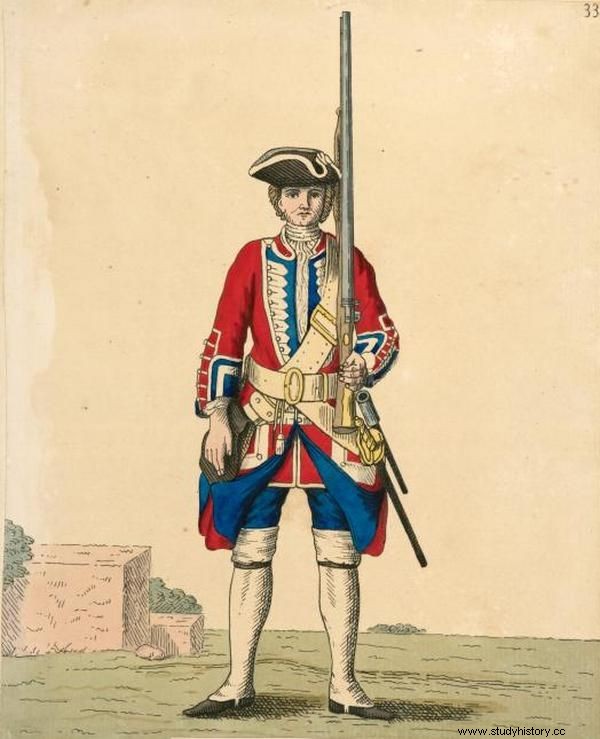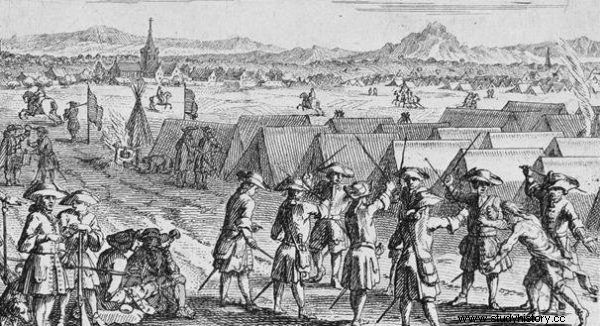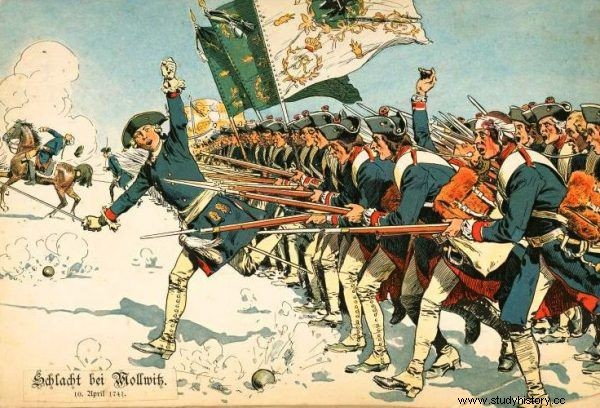Persecution. Humiliating punishments for the slightest offense. Flogging until unconscious. And battles that can only be survived by a miracle. This century may have been a Age of Enlightenment, but certainly not for the rank and file.
The eighteenth century brought a breath of modernity to the European army. The general obligation of military service was introduced, a recruitment system was developed, and the armament and uniforms were standardized. The first service regulations also appeared. This does not mean, however, that military service at that time was easy and light. On the contrary, in many ways, a recruit's life was still like hell.
Wearing boots for life
What military service was for the people of the 18th century is best evidenced by the fact that inclusion into ranks was often used as a punishment for rebels and criminals. It wasn't easy to get a recruit. And because soldiers were needed, more than once people were ... kidnapped into the army against their will. It was practiced, for example, by the Prussians in Poland.
What was so detrimental to a military career? First of all, the service was lifelong until the turn of the 18th and 19th centuries. The one called he fought until old age, if, of course, he managed to live to it. Later, these employment conditions were somewhat eased. Soldiers started to be dismissed after - a trifle - 25 years.
Such regulations were introduced, for example, in Russia in 1793 and in Austria in 1804. Considering the survival rate of soldiers in battle at the time, the change was small. No wonder the recruiting families continued to say goodbye to them as if they would never see them again.

Lifetime service in the army? Such was the fate of the 18th-century recruit. The Battle of Valmy is illustrated.
The life of a soldier was not full of luxuries. The privates had to endure various inconveniences. They could not even count on a roof over their heads. Barracks were not known in all armies . They were not in the Russian army until 1874. The soldiers lived in tents, dugouts and mud huts or in private quarters. The supply issue was equally problematic. The soldiers often had to get food on their own.
In addition, there was frequent persecution in the army. Certain groups were particularly at risk. The young soldiers could be afraid of the so-called wave. Older colleagues deprived them of more valuable items and better uniforms. They were assigned the worst jobs, housing, and food. Those who did not know the language of command, such as Polish peasants incorporated into the Austrian and Russian armies, fared the worst. It caused additional harassment on them.
Representatives of minorities were also treated badly. Believers of religions other than the state religion had to attend services of a different rite without hesitation. The Irish forcibly attended Anglican masses, and Poles in the tsarist army - to the Orthodox ones.
Penalties worse than death
What, apart from the specter of death on the battlefield, must have scared the recruits the most was draconian discipline. Physical punishment was common. The purpose of the brutal methods was to train a soldier to fear his own corporal more than the enemy . They wanted to make the recruits obey blindly. This system was especially perfected in the Prussian army. It was referred to as the Prussian drill. This concept made a European career.
Depending on the degree of the offense, minor and heavy penalties were applied. The former were painful and troublesome, but usually were not fatal. These included, for example, the so-called "gun hold". the victim stood motionless for several hours on the guard, holding in his hands a few muskets, and this is a saddle, and these are cannonballs.
Sitting on a donkey was worse than that. The punished person was seated on a wooden figure of this animal, the back of which ended with a sharp edge covered with sheet metal. The soldier was loaded with several rifles or cannonballs tied in sacks to the legs. The edge was painfully digging into his perineum and anus.

The Prussians were the masters of inculcating blind obedience to recruits. The illustration shows a painting by Carl Röchling showing the attack of Prussian infantry at Hohenfriedeberg.
Another painful punishment was the so-called "stake" or "post". The convict was tied behind his hands to a high stake and pulled tightly so that his feet barely touched the ground. In another variant, he had to stand on pointed pegs, which was painful and additionally made it difficult to keep balance. The punishment of the post was very popular in the 18th and 19th centuries. In some armies it was still used in the 20th century! This is what an Austro-Hungarian soldier recalled her:
Strongest fainted after three quarters of an hour or an hour at most. To bring them back to consciousness, cold water was poured over the victims. The appointed time of punishment, the soldier absolutely had to stand out .

The 18th-century recruit lived with the constant awareness that even the slightest offense would result in painful punishment.
The arsenal of "minor penalties" was very wide. In addition to the penalties already mentioned, for example, spangs were used, i.e. the right hand and the left leg were shackled with short handcuffs, or vice versa. Some convicts had a ball on a chain to their leg. Others had their limbs immobilized with two beams or a split trunk, known as the "log penalty." All these sanctions were imposed in public as a warning to other soldiers.
Sticks and rods
A stake, a donkey, or a log were painful and humiliating, but under heavy punishments, they seemed to be a small game. These, in turn, were sometimes given away even for minor offenses, such as misconduct of a non-commissioned officer, incorrectly arranged gear or badly braided braid.
The most popular was beating an immobilized prisoner with special sticks. They were called corporal because they belonged to the equipment of 18th-century non-commissioned officers and were used precisely to impose punishments and maintain obedience among soldiers. They have even become symbols of military violence , especially in the Prussian army. They were so hated that they were demonstratively burned during the libertarian protests in Germany and Austria during the Spring of Nations.
The soldier might still survive beating with sticks. The chances of this were significantly reduced with flogging. This punishment, used in all 18th and 19th century armies of Europe, was imposed (at least in theory) only for more serious offenses and was ordered by a court. You could get it for a peacetime desertion, for example. Sometimes, however, stubbornness towards an officer or walking in civilian clothes off-duty was enough ...

Caning was theoretically a punishment for the most serious crimes, but sometimes it took really little to be sentenced to it.
What was this draconian punishment like? First, the company's soldiers were arranged in two ranks. Everyone was handed willow or hazel rods, previously soaked in salt water. The condemned man, stripped to his waist, had a lead musket ball in his mouth, on which he could grit his teeth. His legs were fastened with a short chain to keep him from going too fast, and his hands were tied.
Three thousand beats
To the beat of the drum, the condemned man moved forward, and the soldiers successively lashed out at him with their sticks. Along the line of two rows, an officer rode a horse, who checked whether the punishment was being carried out reliably and whether his colleagues would spare their companion. Whenever this happened, the non-commissioned officers in the back immediately punished the lazy with sticks.
Up to 200 soldiers could stand in two rows, so the victim received 200 strokes at the first pass. And it didn't stop there. Depending on the sentence, it was possible to chase a condemned man through this "health path" from six to even 20 times! A greater punishment was not that rare. In the Russian army, there have been cases of soldiers being sentenced to 3,000 strokes.

This article was inspired by the novel by Albert Sánchez Piñola entitled “Victus. The fall of Barcelona 1714 ”(Literary Oficyna Noir Sur Blanc 2018).
When the condemned man fainted and did not have the strength to go on, he was placed on a stretcher with his back up and carried to the end of the row to receive the correct number of strokes . His body was turning into a bloody, wounded pulp.
After measuring the planned number of blows, the profos, i.e. the non-commissioned officer of the military detention, made a decision whether the soldier would go to a cell or to a hospital. Unless, of course, he survived, because there is no doubt that the flogging was actually used to kill the condemned man, and not to punish him in an exemplary manner. Few came out of this torture alive. The few who survived carried traces of it on their skin for the rest of their lives.
Cannon fodder
Drastic methods were used to prepare the recruits for absolute discipline during the fight. The soldiers had to maintain the rhythm of the march, skillfully load their weapons, aim and fire. And all of this is usually under enemy fire, under a hail of cannon and rifle bullets, rumble and smoke.

Draconian training was to make the soldiers fight to the end during the battle. The illustration shows a painting by Wojciech Kossak depicting the Battle of Sarbinowo.
The infantry tactic of that time consisted of marching in a compact formation towards the enemy and firing muskets. The scattered lineage, hiding, crawling, jumping attacks and camouflage have not yet been used. These solutions appeared only at the end of the 19th century.
Let us add that the 18th-century soldiers wore colorful uniforms visible from a distance so that commanders can recognize the location of their troops. This greatly facilitated the opponent's aiming. As a result, exploding artillery shells thinned the marching troops every now and then. The bodies of the soldiers were torn apart by explosions, mutilated, and stripped of their heads, arms and legs. Blood and guts splashed on those walking by.
When enemy missiles breached the ranks, the command "Slack!" The remaining soldiers simply joined their ranks and continued on their way. It was the units that could keep the formation under fire, move forward and change fronts that were considered valuable and well trained.

The punitive troops that could withstand the murderous fire and reach the enemy lines were considered the best trained. The illustration shows the Prussian infantry during the Battle of Małujowice.
When the unit approached the enemy at an attack distance, a bayonet attack followed, followed by hand-to-hand combat. They were stabbed with bayonets, hit with butts, and chopped up with cleavers. Fighting at this stage was not really much different from medieval battles. Survival depended on physical strength and the skillful use of a handheld weapon:a musket, a cleaver, a cannon rod.
Death, poorhouse or… next battle
Only a few were able to survive the hell of battle. Surviving alone was only half the battle, because even the slightest wounds could have serious consequences. Military paramedics usually dealt with the wounded in a hurry, without excessive care and delicacy. They routinely removed bullets and debris, and cleaned and bandaged wounds.
Due to lack of time, they often amputated their crushed limbs without even considering whether they could be saved. They used wound burns to stop the bleeding. All this took place under field conditions, in the evening or at night, by candlelight and torches, without any concern for cleanliness and hygiene. Many of the injured died of infection afterwards.

Permanent disability equaled removal from the army. As a result, the streets were teeming with former mutilated soldiers.
In addition, if the battle lasted overnight, the victims had to wait for help until the morning. This greatly reduced their chances of survival. The sanitary groups, which usually, if the fighting ended at dusk, would gather the wounded in the evening, did not risk acting in the dark.
Wounded from the opposing army were usually finished off by the victors or by marauders looking for prey on the wounded and killed. First of all, their own soldiers were helped. And you have to remember that it was an emergency. Those who became invalids as a result of their wounds were removed from the army . They were sent to an asylum for military invalids, but if there was no place for them, the fate of a soldier-beggar awaited them. For centuries, the mendicant war invalid was a normal and frequent sight on the streets of European cities.
And what was the fate of those who survived and kept healthy? They returned to the ranks and proceeded to the next battle. Hopefully it won't be the last one yet.
Inspiration:
This article was inspired by the novel by Albert Sánchez Piñola entitled “Victus. The fall of Barcelona 1714 ”, Literary Oficyna Noir Sur Blanc 2018.
